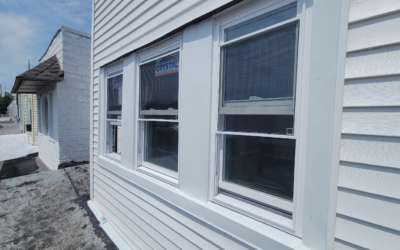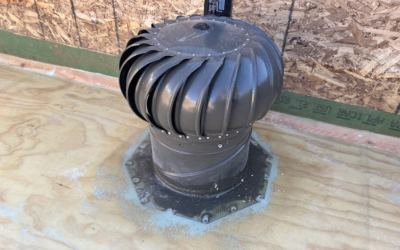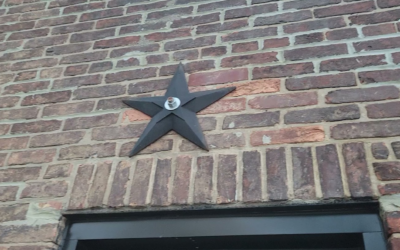Dupont Tyvek HomeWrap is a famous name in the construction industry. It is not just a simple covering; it is a critical component of any building’s exterior protection to protect your home from water and damage. Even though Tyvek installation might seem easy, the reality is that even the smallest mistakes can lead to water infusion and damage your property.
This article discusses common Tyvek installation mistakes people make when using Tyvek and how to fix them. Whether you are a professional builder or a DIY enthusiast, understanding how to use Tyvek HomeWrap is crucial to keeping your building safe from water and making it last a long time. Read this article before starting your installation!
1. Installing Tyvek at the Wrong Time
During Tyvek installation, timing is critical to avoid mistakes. It is important to install Tyvek HomeWrap at a specific stage during the construction process. Here’s when you should install it:
- After the roof sheathing is in place.
- After the step flashing
and kick-out flashing
are set up.
- Before you put in the windows and doors.
2. Choosing the Wrong Type of Tyvek
Another common Tyvek installation mistake is choosing the wrong type of Tyvek. Not all Tyvek is the same. You should select one that fits your project. If you use the incorrect type, it may not function properly. So, make sure you pick the right Tyvek for your job to keep your home safe and dry.
3. Failing to Consider Continuity
To install Tyvek HomeWrap correctly, you should start at the bottom and keep wrapping it all the way up. Each layer should overlap the one below by at least 6 inches. If this is not done correctly (see Figure 1), water can find its way in.
Figure 1
4. Not Properly Integrating Flashing
Another Tyvek installation mistake is not connecting it properly to the window and door flashing. Imagine Tyvek being a barrier that keeps water out, like a raincoat for your house. To ensure proper waterproofing, it is crucial to integrate it with window and door flashing to prevent water infiltration.
It is important to note that the first layer of Tyvek HomeWrap, at the top, should be placed underneath the roof’s drip edge. However, the lowest layer should be over the step flashing. This arrangement ensures that when water gets in, it will slide down the Tyvek paper and exit straight down at the bottom. This helps to keep your house dry and safe.
In Figure 2, the correct order is as follows:
The drip edge should be placed over the Tyvek layer.
The upper layer of Tyvek should overlap the layer below it.
The bottom step flashing should be placed over the Tyvek layer.
Figure 2
5. Skipping the Post-Installation Check
After you’ve wrapped your house with Tyvek, it’s important to double-check everything. Start by inspecting the roof to ensure that the installation is correct. Tyvek should act like a river, guiding water away from your home. If it’s not functioning properly, it could cause problems.
It’s advisable to inspect your work during rainy weather to ensure there are no leaks or water coming in. This way, you can catch any issues early and fix them before they become bigger problems. Remember to thoroughly check your Tyvek HomeWrap job after installation, especially during rainy weather.
6. Not Using Fasteners Properly
Using fasteners correctly will make your Tyvek HomeWrap stay securely in place. However, it is a detail that many people tend to overlook, yet it plays a vital role in the effectiveness of your Tyvek installation.
To get it right, position these fasteners along the vertical stud lines approximately 6 to 18 inches apart. But be careful not to put them within 6 inches of the sills and jambs (the bottom and side edges of your windows and doors) or within 9 inches of the top of your window openings.
It is crucial to use the correct type of fasteners as suggested by the manufacturer. Often, they will specify options like DuPont Tyvek Wrap Cap Nails, Screws, or Staples. You can also opt for equivalent fasteners from other brands that serve the same purpose. These small but vital details ensure that your Tyvek HomeWrap functions effectively.
7. Choosing the Wrong Window Flashing
It is important to use window flashing designed to work with Tyvek. If incompatible flashing is used, it does not fit well, especially in the corners. To make incompatible flashing work, you could end up folding and cutting multiple pieces like origami to fit around corners. This creates seams in different places, and where there are seams, water can find its way in.
To avoid this hassle and keep your home dry, it is best to go with a product like DuPont Flex Wrap. It works seamlessly with Tyvek, so you do not have to play around with folding and cutting. It easily fits around corners, helping you create a watertight barrier.
8. Taping Over Fasteners
When you attach Tyvek using fasteners, it might seem like a good idea to tape over them for better protection. However, this can create a problem. Taping over fasteners can allow water to sneak in and reach the fastener underneath. To avoid this Tyvek installation mistake, it is important to ensure that the fasteners are placed at least 6 inches away from any seams in the Tyvek. By doing so, you can prevent water from having a direct path to the fasteners, and keep them safe from damage.
9. Ignoring Damage
When installing Tyvek, it’s possible to come across small tears or holes in the material. While they may seem insignificant, they should not be ignored. Even the smallest holes can allow water to seep in, leading to significant issues.
To fix this, tape up all the tears. Use something like DuPont Tyvek Tape (2 or 3 inches wide) or DuPont Self-Adhered Flashing Products.
Figure 3
For holes larger than 1 inch, you might need to do a bit more.
Here is what to do:
- Cut a slit 2 inches above the hole, extending it at least 2 inches on each side of the hole.
- Measure and cut a piece of Tyvek to fit into the slit and cover the hole.
- Tuck the cut piece of Tyvek into the slit.
- Tape along the edges by starting at the bottom and folding the top tape over the bottom tape.
Figure 4
10. Ignoring the User Instructions
One of the simplest yet most common mistakes is ignoring the instructions that come with your Tyvek HomeWrap. When you get Tyvek, it usually comes with instructions on how to use it. Ignoring these instructions can lead to errors and reduce the protection Tyvek provides.
It is important to carefully read and understand the installation instructions included with your Tyvek HomeWrap. These instructions contain valuable information and tips to help ensure a smooth installation process and protect your home from water damage.
Conclusion
To sum up, Tyvek HomeWrap is an excellent material for waterproofing your building, but it must be used correctly to be effective. Tyvek installation mistakes can waste your time and money, and they may even cause significant issues for your property in the future. Therefore, it is crucial to carefully read and follow the instructions provided and avoid the mistakes we have mentioned based on our experience.
If you are uncomfortable handling Tyvek installation yourself, it is always a good idea to consult an expert. Our team at Matrix Company Solutions Corp. is here to support you at every stage of your home renovation project in the Philadelphia and South Jersey areas. Don’t hesitate to contact us for a FREE Consultation and Estimate. Your home’s protection is our priority.
Step flashing is a kind of flashing that is used to stop water from getting inside the walls where the roof and walls meet.
Kick-out flashing is like a slope or ramp that helps to move rainwater into the rain gutters.








Can tyvek tape be painted over?
Hi Kathy
Thanks for your comment. Yes, tyvek tape is paintable and compatible with many coatings and sealants. Ensure the tape is clean and dry, and use a compatible primer and paint for better adhesion. Note that its smooth surface may reduce long-term durability of the paint. Test a small area first for best results.
Sweet blog! I found it while surfing around on Yahoo News.
Do you have any tips on how to get listed in Yahoo News?
I’ve been trying for a while but I never seem to get there!
Cheers
Thanks for sharing your thoughts about my first project.
Regards
I believe what you posted was actually very reasonable. But,
what about this? what if you added a little information? I am not suggesting your information isn’t solid., but what if you added something that grabbed folk’s attention? I mean 10 Common Mistakes to Avoid
When Installing Tyvek HomeWrap is a little plain. You could
glance at Yahoo’s front page and note how they create
news titles to get viewers to click. You might try adding a video or a pic or two to grab readers
excited about what you’ve written. In my opinion, it might make your posts a little livelier.
для нашего бизнесса качество и свежесть продуктов имеют первостепенное значение, надежные холодильные системы становятся залогом успешного бизнеса. Друзья, подскажите ресурсы где есть широкий ассортимент и доступная цена на https://moros-holodos.ru/ – холодильники
my webpage; “https://t.me/s/cryptonetlake”
Идеальная чистота вашего дома или офиса — это гораздо ближе, чем вы думаете! Наша клининговая компания предоставляет квалифицированные услуги уборки в Санкт-Петербурге. Мы внимательны о каждом уголке, высвобождая вас от рутины и позволяя упиваться досугом. Используем только экологически чистые и действенные средства, и передовые технологии для достижения безупречного результата. Перемещайтесь к https://clean-help24.ru – Служба клининга Наши неоспоримые преимущества: Квалифицированные специалисты по чистоте, удобный для вас график и внимание к вашим пожеланиям к абсолютно всем. Доверьтесь профессионалам и просто расслабьтесь. Мы облегчим вашу рутину! Звоните немедленно и пригласите чистоту в свой дом прямо сейчас!
Ищете проверенную помощь в наведении порядка вашей в Санкт-Петербурге? Наша команда специалистов дает гарантию чистоту и и порядок в вашем доме! Мы применяем только безопасные и действенные средства, чтобы вы могли наслаждаться свежестью без хлопот. Двигайтесь к Клининг уборка после ремонта Не прозевайте уникальную возможность сделать свою жизнь проще и удобнее.
In today’s digital world, having a reliable and secure email service is crucial. Whether for personal use, business, or online communication, you need a platform you can trust. That’s where **Inbox247.org** shines—it’s not just another email provider; it’s the **best and safest** choice available. **Top-Notch Security** Security is a major concern for anyone using email, and Inbox247.org takes it seriously. With **end-to-end encryption**, your messages stay private and protected from hackers. Unlike some mainstream providers, Inbox247.org doesn’t scan your emails for ads or sell your data. Your privacy is their priority. **User-Friendly Interface** Even if you’re not tech-savvy, Inbox247.org makes email management easy. The clean, intuitive design ensures smooth navigation. Whether you’re composing an email, organizing folders, or setting up filters, everything is straightforward and efficient. **No Ads, No Tracking** Tired of being bombarded with ads? Inbox247.org offers an **ad-free experience**, so you can focus on what matters—your emails. Plus, with **zero tracking**, your online activity remains yours alone. **Generous Storage & Fast Performance** Running out of space? Inbox247.org provides **ample storage** for all your emails and attachments. The service is also optimized for speed, ensuring quick loading times and smooth performance, even with large files. **24/7 Customer Support** Great support makes a difference. Inbox247.org offers **round-the-clock assistance**, so help is always available when you need it. Whether it’s a technical issue or a simple question, their team is ready to assist. **Final Verdict** If you’re looking for an email service that combines **security, simplicity, and reliability**, **Inbox247.org** is the perfect choice. Say goodbye to privacy concerns and cluttered interfaces—switch to Inbox247.org today and experience email the way it should be!
Устали от досадных уборок и вездесущей пыли? Клининговая компания в Санкт-Петербурге предлагает первоклассные услуги по уборке жилых и коммерческих помещений. Мы заботимся о вашем времени, используя только безопасные и эффективные средства. Наша команда профессионалов подарит вашему дому или офису сиянием и порядок, а вам — безмятежность и гармонию. Двигайтесь к https://uberu21.ru Вверьте наведение порядка нам и наслаждайтесь временем, проведенным с семьей и приятелями! Забронируйте на безвозмездную консультацию прямо сейчас и получите специальные предложения для вновь прибывших клиентов. Чистота — это не только работа, это наше предназначение!
Друзья, рекомендуем Вам – надёжный [url=https://naberezhnie-chelni.ohranatruda-shop.ru/review/znaki-opasnosti-gruzov-i-markirovka-truboprovodov-i-kabeley/]партнёр[/url] в сети!
Буду рад ответить на все вопросы!
Thanks for your post. I like your work you can also check mine anchor text
Разыскиваете надежную помощь в уборке квартиры в Санкт-Петербурге? Наша группа профессионалов гарантирует чистоту и порядок в вашем доме! Мы применяем только безопасные и эффективные средства, чтобы вы могли наслаждаться свежестью без хлопот. Кликайте Клининговые услуги петербург
Кроме того, автосервис 5 бокс https://5-boks.clients.site в Санкт-Петербурге используют современное оборудование и качественные запчасти, что гарантирует долгую и безопасную эксплуатацию вашего автомобиля. Поэтому не стоит откладывать визит в автосервис, если у вас возникли проблемы с машиной.